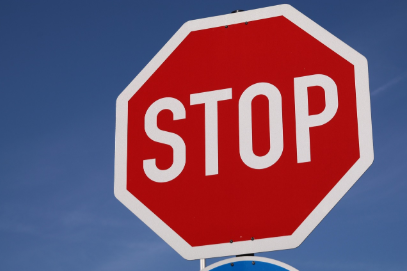The Meaning Behind a Blue Stop Sign
When it comes to road signs, the standard red stop sign is widely recognized as a signal for drivers to come to a complete stop. However, you might occasionally come across an unusual variation: the blue stop sign. While blue stop signs are not as commonly seen as their red counterparts, they do exist and serve a distinct purpose in specific contexts. Understanding the role of these blue signs, as well as their history and the regulations surrounding them, can help drivers navigate safely and effectively.
The Role of Blue Stop Signs
Unlike the red stop signs that are universally recognized as regulatory signs under the jurisdiction of the U.S. Department of Transportation, blue stop signs have a different function. These signs are typically found on private property—for example, in gated communities, shopping mall parking lots, or private business areas. They are not governed by federal traffic regulations and do not carry the same legal weight as the traditional red stop signs that are found on public roads.
Blue stop signs are often used for non-regulatory purposes such as directing traffic, guiding vehicles through private spaces, or fulfilling aesthetic or design-related goals in specific locations. Because they are not legally required, drivers should be aware that they do not carry the same authority as red stop signs. However, this doesn’t mean they should be ignored.
Why Are Blue Stop Signs Used?
The primary reason behind the use of blue stop signs is that they serve a unique function on private property. For example, in gated communities or private businesses, blue stop signs might be installed to help regulate traffic flow or enhance visibility in areas where traffic is likely to be less heavy. In some cases, businesses or private property owners may use blue stop signs to create a distinctive look or maintain a consistent aesthetic theme throughout the property.
These blue stop signs may also be used for safety purposes in certain areas that may not be covered by public traffic laws. For instance, in a parking lot or private driveway, the sign might be there to slow down traffic or ensure that vehicles stop at certain intersections before moving forward. Even though the blue stop sign is not legally binding, it is often put in place to guide drivers in a way that enhances safety.
The Evolution of Stop Sign Colors

To understand why blue stop signs are not more common, it’s helpful to look at the history of stop sign design. Historically, stop signs were originally yellow with black lettering, serving as a clear and highly visible signal for drivers to stop. This design was used until the 1950s, when a shift occurred to the now-familiar red stop sign.
The red stop sign was chosen because it offers superior visibility in both day and night conditions. The color red is widely associated with danger, warnings, and alerts, making it an effective color for signaling drivers to stop immediately. Additionally, red stands out against natural backgrounds, such as greenery or urban environments, making it highly visible from a distance.
The red color’s ability to capture attention and signal urgency was a significant factor in its adoption as the standard for regulatory stop signs, and it has remained the color of choice for these signs ever since.
The Difference Between Blue and Red Stop Signs
One key difference between blue and red stop signs lies in the legal authority and visibility of each. While red stop signs are legally binding and enforced by traffic laws, blue stop signs are generally used for more localized, non-regulatory purposes. Blue stop signs might not have the same urgent connotation that a red stop sign carries. They are often employed in private or non-public spaces where traffic laws do not apply in the same way they do on public roads.
Despite not having legal authority in the same way red stop signs do, blue stop signs can still play an important role in maintaining traffic flow and preventing accidents in private areas. If you encounter a blue stop sign, it’s typically a good idea to treat it with the same level of caution you would a regular stop sign, as ignoring it could lead to unsafe driving conditions or even conflict with local enforcement in private spaces.
What to Do When You See a Blue Stop Sign
When driving in private areas such as parking lots or gated communities, always prioritize safety and remain alert to any signage. Although blue stop signs do not carry the legal weight of red stop signs, they are still installed for specific reasons, such as guiding traffic, promoting safety, or directing drivers to stop at intersections. Ignoring these signs could result in accidents, misunderstandings, or other safety issues.
Even if a blue stop sign is not legally enforceable, following its instructions is still a good practice to ensure safe driving. It’s important to note that while you may not face legal penalties for failing to stop at a blue stop sign, you could still encounter private property enforcement or potential accidents if the sign is there for safety purposes. Always be respectful of local traffic policies, whether public or private, to maintain safety and good relations with other drivers and property owners.
The Importance of Clear and Consistent Signage
In the larger context of road safety, clear and consistent signage plays an essential role in guiding drivers and preventing accidents. The introduction of blue stop signs, while unconventional, serves to highlight the diversity of signage and its role in creating safe driving environments. While blue stop signs are not regulated in the same manner as their red counterparts, they are a reminder that signage exists not only for regulatory purposes but also for safety, convenience, and aesthetic design.
As public awareness of these blue stop signs increases, drivers may become more accustomed to seeing them in certain areas. It’s important that drivers understand that these signs are not to be disregarded simply because they are blue. Ignoring any stop sign, regardless of its color, can result in accidents or disruptions to the smooth flow of traffic, even in private spaces.
Conclusion: Safety First, Regardless of Sign Color
In conclusion, while blue stop signs may not be legally required or as ubiquitous as red stop signs, they serve a valid and important role in certain private spaces. Whether guiding traffic, enhancing visibility, or contributing to the aesthetic of a space, blue stop signs are a helpful reminder that signage can come in many forms. Regardless of the color, it’s essential to treat all stop signs with care and respect to ensure the safety of all individuals on the road, whether it’s a public highway or a private parking lot.
So, the next time you come across a blue stop sign, remember to exercise caution and follow its instructions—it may not be backed by the law in the same way red stop signs are, but it is there for a reason: safety. When it comes to traffic, no sign should be ignored.

